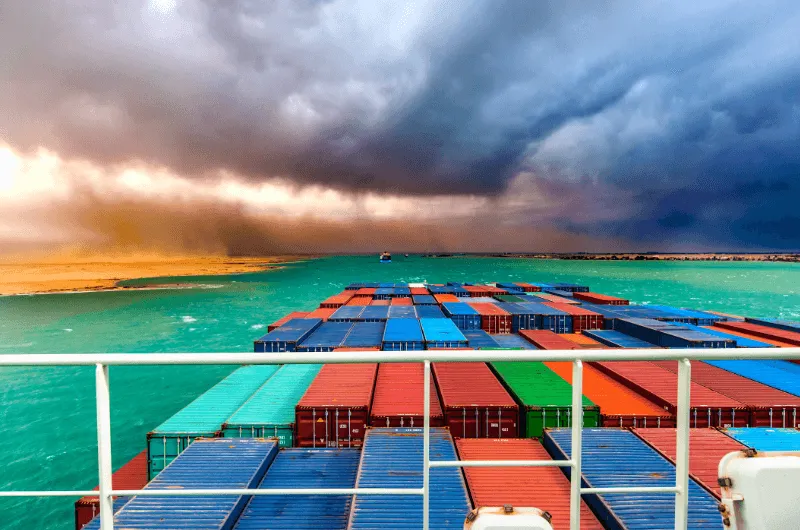History of the Suez Canal

The Suez Canal is one of the most important waterways in the world. Although it has existed for approximately 150 years, the ideas and plans for its construction are much older. What is its history, and why was it—and still is—an extremely important waterway? You will find out everything in today’s article.
Where is the Suez Canal and when was it opened?
The Suez Canal (in French: Canal de Suez) is located in Egypt, connecting the Mediterranean and Red Seas, and passes through the Suez Isthmus. The construction of the Suez Canal took 10 years, and it was ceremonially opened in 1869. Over the following years, it underwent several modifications and expansions.
The Suez Canal shortened the sea route from Asia to Europe by approximately 9,000 km (5,600 mi) and was extremely significant for European overseas trade in Africa. Previously, sailors wishing to travel from the Mediterranean Sea to the Red Sea had to circumnavigate the entire continent of Africa around the Cape of Good Hope or transport cargo overland.
Predecessors of the Suez Canal
The map of an ancient “Suez Canal” dates back to the 13th century BCE, when the Egyptians successfully connected the Red Sea and the Nile River delta. However, the Nile River was gradually filled with sediment, leading to the demise of the waterway. The ancient canal was subsequently revived several times by the Persians, Romans, and Arabs.
The modern Suez Canal and its history
Ideas for the current form of the Suez Canal began to emerge in the 16th century. The Venetians sought permission for its construction, and Napoleon Bonaparte also expressed interest during his campaign in Egypt, but he received a negative “assessment” due to the significant difference in sea levels between the two seas and abandoned the plans.
It wasn’t until the 1830s that engineer, diplomat, and Cairo consul Ferdinand de Lesseps commissioned a detailed project and obtained a concession for the construction of the canal from the Egyptian viceroy. The company for the construction of the canal was founded in 1857, with investors from France, Italy, Austria, Egypt, Russia, and the USA. Paradoxically, Great Britain, which stood to gain a lot from the construction, initially tried to prevent it.
Opening of the Suez Canal
The construction of the Suez Canal began in 1859 and was completed in 1869. The Suez Canal was 164 km (102 mi) long and 8 m (26.24 ft) deep. Traffic was one-way (part of the day in one direction, part of the day in the other). The journey through the Suez Canal took approximately 18 hours, and 49 boats passed through it daily.
The Suez Canal as a venue for international conflicts
In 1888, the canal was declared neutral territory under British administration based on the Convention of Constantinople. During World War II, the Germans and Italians attempted to capture it. In 1956, Egypt nationalized the canal, leading to the Suez Crisis, during which it became the site of conflict between Egypt and the coalition of Israel, the United Kingdom, and France. In the second half of the 20th century, the Suez Canal was part of prolonged conflicts and battles between Israel and Egypt.
A container ship blocks the Suez Canal
Fairly recently, in 2021, the container ship Ever Given, carrying nearly 20,000 containers, blocked the Suez Canal. The accident was likely caused by strong winds. The ship blocked the canal’s southern entrance for six days, preventing 400 ships from around the world from passing through.
Why the Suez Canal is important
Currently, 20,000 ships pass through the Suez Canal each year, and it remains the shortest route connecting Europe and Asia. Its most recent expansion took place in 2015. The current length of the Suez Canal is 193 km (120 mi), and its depth is 24 m (79 ft). The journey through it now takes 10 hours, with 97 ships passing through daily, and the traffic is bidirectional.
Ti potrebbe interessare:
Segui guruhitech su:
- Google News: bit.ly/gurugooglenews
- Telegram: t.me/guruhitech
- Facebook: facebook.com/guruhitechweb
- Twitter: twitter.com/guruhitech1
- Instagram: instagram.com/guru_hi_tech/
- Threads: threads.net/@guru_hi_tech
- GETTR: gettr.com/user/guruhitech
- Rumble: rumble.com/user/guruhitech
- VKontakte: vk.com/guruhitech
- MeWe: mewe.com/i/guruhitech
- Skype: live:.cid.e496a29c3d8dfd2
- WhatsApp: bit.ly/whatsappguruhitech
Esprimi il tuo parere!
Ti è stato utile questo articolo? Lascia un commento nell’apposita sezione che trovi più in basso e se ti va, iscriviti alla newsletter.
Per qualsiasi domanda, informazione o assistenza nel mondo della tecnologia, puoi inviare una email all’indirizzo guruhitech@yahoo.com.
